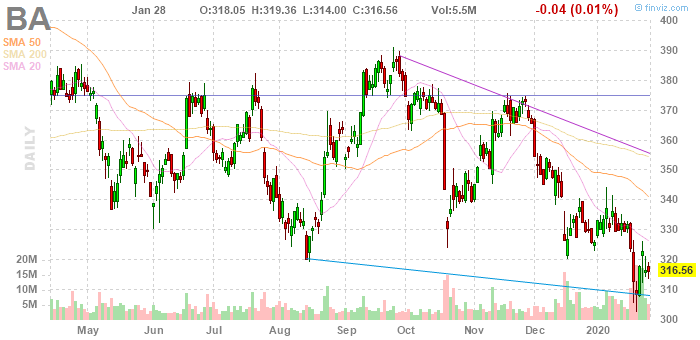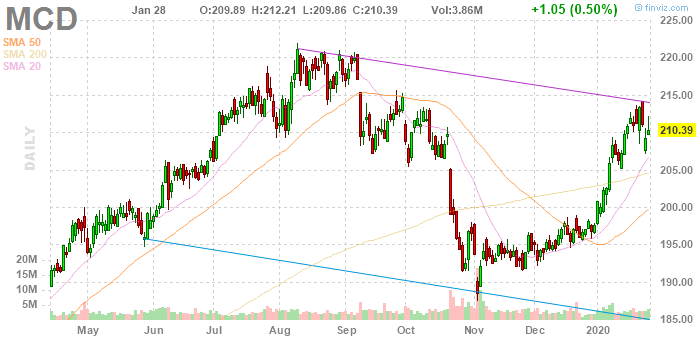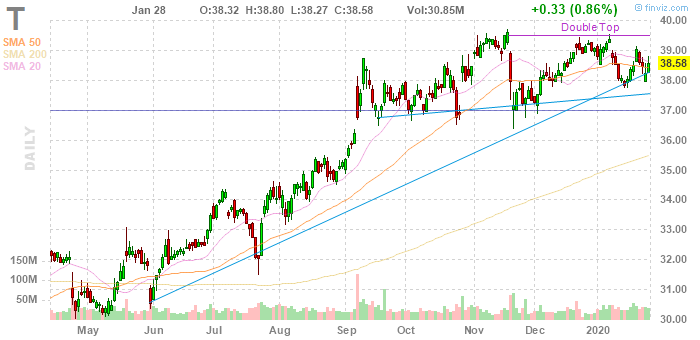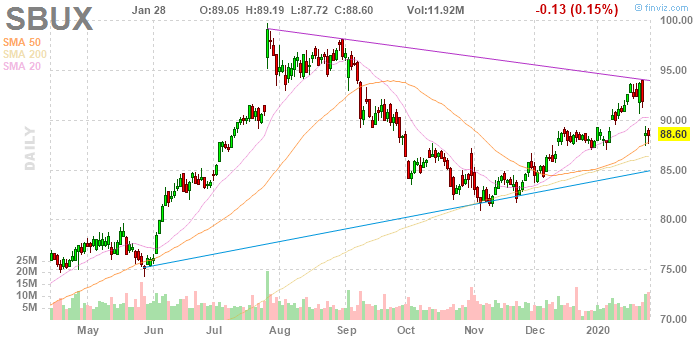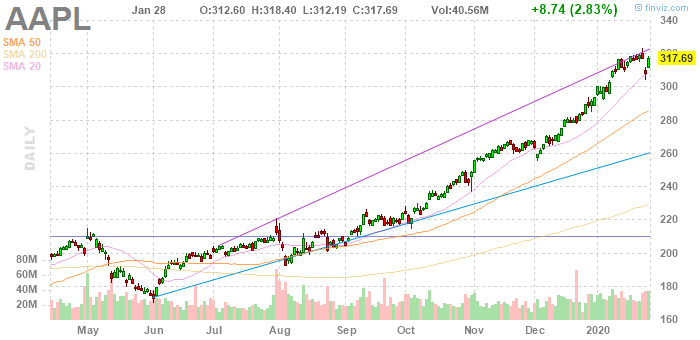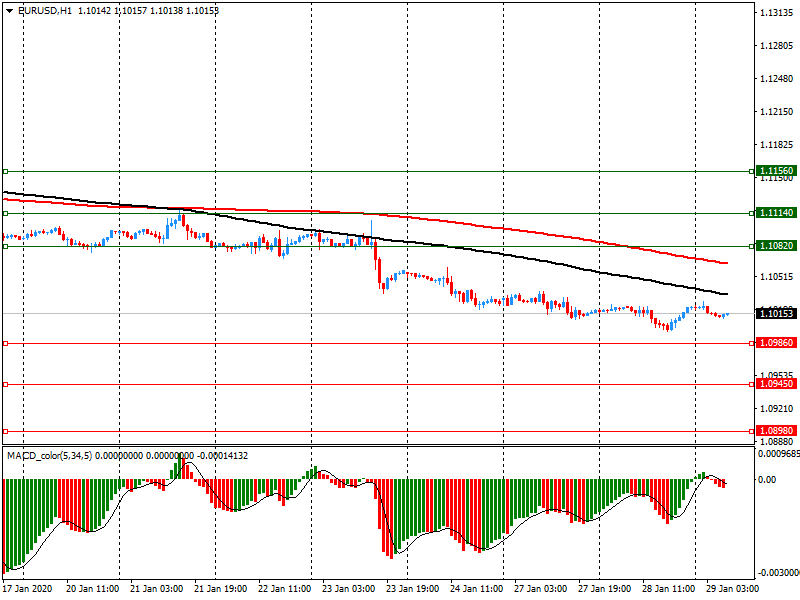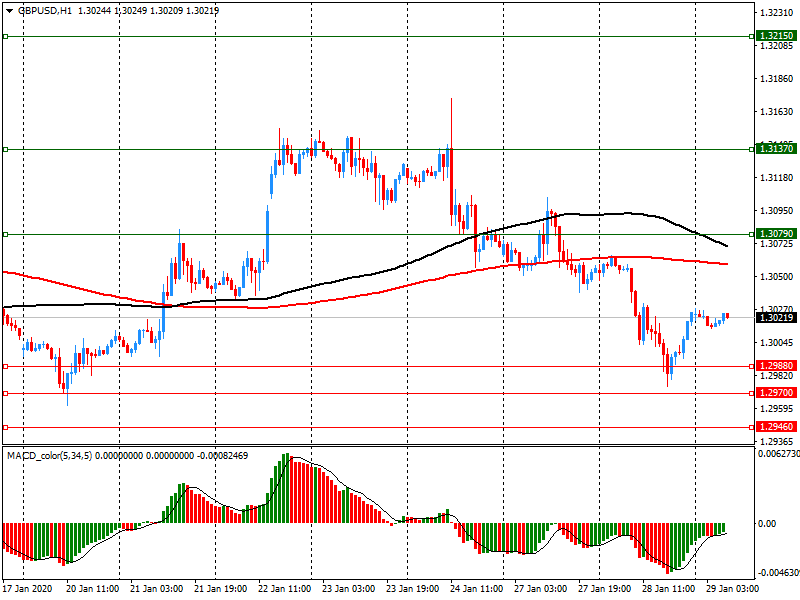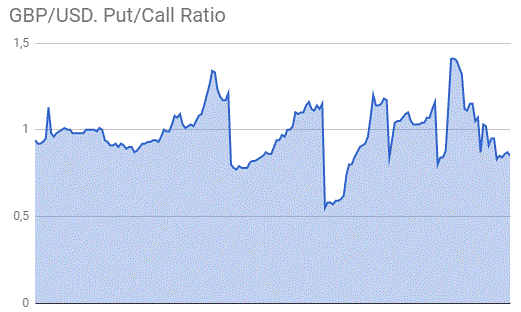- Analiza
- Novosti i instrumenti
- Vesti sa tržišta
Forex-novosti i prognoze od 29-01-2020
| Time | Country | Event | Period | Previous value | Forecast |
|---|---|---|---|---|---|
| 00:30 | Australia | Export Price Index, q/q | Quarter IV | 1.3% | -5.4% |
| 00:30 | Australia | Import Price Index, q/q | Quarter IV | 0.4% | 0% |
| 08:00 | Switzerland | KOF Leading Indicator | January | 96.4 | 97 |
| 08:55 | Germany | Unemployment Change | January | 8 | 5 |
| 08:55 | Germany | Unemployment Rate s.a. | January | 5% | 5% |
| 10:00 | Eurozone | Industrial confidence | January | -9.3 | -8.7 |
| 10:00 | Eurozone | Business climate indicator | January | -0.25 | -0.19 |
| 10:00 | Eurozone | Consumer Confidence | January | -8.1 | -8.1 |
| 10:00 | Eurozone | Economic sentiment index | January | 101.5 | 101.8 |
| 10:00 | Eurozone | Unemployment Rate | December | 7.5% | 7.5% |
| 12:00 | United Kingdom | BOE Inflation Letter | |||
| 12:00 | United Kingdom | Bank of England Minutes | |||
| 12:00 | United Kingdom | Asset Purchase Facility | 435 | 435 | |
| 12:00 | United Kingdom | BoE Interest Rate Decision | 0.75% | 0.75% | |
| 12:30 | United Kingdom | BOE Gov Mark Carney Speaks | |||
| 13:00 | Germany | CPI, y/y | January | 1.5% | 1.7% |
| 13:00 | Germany | CPI, m/m | January | 0.5% | -0.6% |
| 13:30 | U.S. | Continuing Jobless Claims | January | 1731 | 1733 |
| 13:30 | U.S. | PCE price index, q/q | Quarter IV | 1.5% | 1.7% |
| 13:30 | U.S. | Initial Jobless Claims | January | 211 | 215 |
| 13:30 | U.S. | GDP, q/q | Quarter IV | 2.1% | 2.1% |
| 18:00 | Germany | German Buba President Weidmann Speaks | |||
| 23:30 | Japan | Unemployment Rate | December | 2.2% | 2.3% |
| 23:30 | Japan | Tokyo CPI ex Fresh Food, y/y | January | 0.8% | 0.8% |
| 23:30 | Japan | Tokyo Consumer Price Index, y/y | January | 0.9% | 0.9% |
| 23:50 | Japan | Retail sales, y/y | December | -2.1% | -1.8% |
| 23:50 | Japan | Industrial Production (MoM) | December | -1% | 0.7% |
| 23:50 | Japan | Industrial Production (YoY) | December | -8.2% | -2.4% |
| Time | Country | Event | Period | Previous value | Forecast |
|---|---|---|---|---|---|
| 00:30 | Australia | Export Price Index, q/q | Quarter IV | 1.3% | -5.4% |
| 00:30 | Australia | Import Price Index, q/q | Quarter IV | 0.4% | 0% |
| 08:00 | Switzerland | KOF Leading Indicator | January | 96.4 | 97 |
| 08:55 | Germany | Unemployment Change | January | 8 | 5 |
| 08:55 | Germany | Unemployment Rate s.a. | January | 5% | 5% |
| 10:00 | Eurozone | Industrial confidence | January | -9.3 | -8.7 |
| 10:00 | Eurozone | Business climate indicator | January | -0.25 | -0.19 |
| 10:00 | Eurozone | Consumer Confidence | January | -8.1 | -8.1 |
| 10:00 | Eurozone | Economic sentiment index | January | 101.5 | 101.8 |
| 10:00 | Eurozone | Unemployment Rate | December | 7.5% | 7.5% |
| 12:00 | United Kingdom | BOE Inflation Letter | |||
| 12:00 | United Kingdom | Bank of England Minutes | |||
| 12:00 | United Kingdom | Asset Purchase Facility | 435 | 435 | |
| 12:00 | United Kingdom | BoE Interest Rate Decision | 0.75% | 0.75% | |
| 12:30 | United Kingdom | BOE Gov Mark Carney Speaks | |||
| 13:00 | Germany | CPI, y/y | January | 1.5% | 1.7% |
| 13:00 | Germany | CPI, m/m | January | 0.5% | -0.6% |
| 13:30 | U.S. | Continuing Jobless Claims | January | 1731 | 1733 |
| 13:30 | U.S. | PCE price index, q/q | Quarter IV | 1.5% | 1.7% |
| 13:30 | U.S. | Initial Jobless Claims | January | 211 | 215 |
| 13:30 | U.S. | GDP, q/q | Quarter IV | 2.1% | 2.1% |
| 18:00 | Germany | German Buba President Weidmann Speaks | |||
| 23:30 | Japan | Unemployment Rate | December | 2.2% | 2.3% |
| 23:30 | Japan | Tokyo CPI ex Fresh Food, y/y | January | 0.8% | 0.8% |
| 23:30 | Japan | Tokyo Consumer Price Index, y/y | January | 0.9% | 0.9% |
| 23:50 | Japan | Retail sales, y/y | December | -2.1% | -1.8% |
| 23:50 | Japan | Industrial Production (MoM) | December | -1% | 0.7% |
| 23:50 | Japan | Industrial Production (YoY) | December | -8.2% | -2.4% |
- Committee is to weigh whether the outbreak of a novel coronavirus amounts to a global health emergency
The U.S. Energy Information Administration (EIA) revealed on Wednesday that crude inventories climbed by 3.548 million barrels in the week ended January 24. Economists had forecast an advance of 0.460 million barrels.
At the same time, gasoline stocks rose by 1.203 million barrels, while analysts had expected a gain of 1.320 million barrels. Distillate stocks fell by 1.289 million barrels, while analysts had forecast a decrease of 1.095 million barrels.
Meanwhile, oil production in the U.S. was unchanged at 13.000 million barrels a day.
U.S. crude oil imports averaged 6.7 million barrels per day last week, up by 229,000 barrels per day from the previous week.
The National Association of Realtors (NAR) announced on Wednesday its seasonally adjusted pending home sales index (PHSI) dropped 4.9 percent m-o-m to 103.2 in December, after an unrevised 1.2 percent m-o-m advance in November.
Economists had expected pending home sales to increase 0.4 percent m-o-m in December.
On y-o-y basis, the index climbed 4.6 percent after a 7.4 percent surge in November.
According to the report, all regional indices recorded declines m-o-m in December. The Northeast PHSI fell 4.0 percent m-o-m to 92.4 in December, 0.1 percent lower than a year ago. In the Midwest, the index decreased 3.6 percent m-o-m to 98.8 last month, 1.3 percent higher than in December 2018. Pending home sales in the South dropped 5.5 percent m-o-m to an index of 118.1 in December, a 7.4 percent advance from December 2018. The index in the West tumbled 5.4 percent m-o-m in December 2019 to 93.1, a gain of 7.0 percent from a year ago.
The Mortgage Bankers Association (MBA) reported on Wednesday the mortgage application volume in the U.S. climbed 7.2 percent in the week ended January 24, following a 1.2 percent drop in the previous week.
According to the report, refinance applications jumped 7.5 percent, while applications to purchase a home surged 5.3 percent.
Meanwhile, the average fixed 30-year mortgage rate dropped to 3.81 percent from 3.87 percent.
"Mortgage applications continued their strong start to the year, as borrowers acted on the drop in mortgage rates last week," noted Joel Kan, an MBA economist. "Rates were driven lower by investors' increased concern about the economic impact from China's coronavirus outbreak, in addition to existing concerns over trade and other geopolitical risks."
- Sees risk of cliff-edge at end-2020 on fisheries and trade
- Says EU will link fisheries to trade and level playing field discussions
- Will not give ground on key interests, will seek to apply the EU state aid rules to the UK after Brexit
U.S. stock-index futures rose on Wednesday, as upbeat quarterly results/guidance from Apple (AAPL) and several other marquee companies overshadowed concerns over the economic impact of the fast-spreading coronavirus.
Global Stocks:
| Index/commodity | Last | Today's Change, points | Today's Change, % |
| Nikkei | 23,379.40 | +163.69 | +0.71% |
| Hang Seng | - | - | - |
| Shanghai | - | - | - |
| S&P/ASX | 7,031.50 | +37.00 | +0.53% |
| FTSE | 7,494.54 | +13.85 | +0.19% |
| CAC | 5,952.45 | +26.63 | +0.45% |
| DAX | 13,346.54 | +22.85 | +0.17% |
| Crude oil | $53.91 | | +0.80% |
| Gold | $1,569.90 | | +0.01% |
(company / ticker / price / change ($/%) / volume)
| 3M Co | MMM | 166.2 | 0.62(0.37%) | 15398 |
| ALCOA INC. | AA | 14.61 | -0.10(-0.68%) | 13900 |
| ALTRIA GROUP INC. | MO | 50.2 | 0.03(0.06%) | 1664 |
| Amazon.com Inc., NASDAQ | AMZN | 1,863.94 | 10.69(0.58%) | 25286 |
| American Express Co | AXP | 133.53 | 1.08(0.82%) | 1598 |
| Apple Inc. | AAPL | 323.1 | 5.41(1.70%) | 976841 |
| AT&T Inc | T | 38.44 | -0.14(-0.36%) | 529199 |
| Boeing Co | BA | 326.5 | 9.94(3.14%) | 957103 |
| Caterpillar Inc | CAT | 137.07 | 0.33(0.24%) | 1699 |
| Chevron Corp | CVX | 111.7 | 0.58(0.52%) | 1122 |
| Cisco Systems Inc | CSCO | 47.85 | 0.08(0.17%) | 16795 |
| Citigroup Inc., NYSE | C | 77.28 | 0.04(0.05%) | 18734 |
| Exxon Mobil Corp | XOM | 64.96 | 0.31(0.48%) | 58798 |
| Facebook, Inc. | FB | 221.08 | 3.29(1.51%) | 293838 |
| FedEx Corporation, NYSE | FDX | 148.78 | 0.38(0.26%) | 1348 |
| Ford Motor Co. | F | 8.86 | 0.04(0.45%) | 228264 |
| Freeport-McMoRan Copper & Gold Inc., NYSE | FCX | 11.35 | 0.05(0.44%) | 16212 |
| General Electric Co | GE | 12.7 | 0.97(8.27%) | 12299189 |
| General Motors Company, NYSE | GM | 33.85 | 0.21(0.62%) | 2664 |
| Goldman Sachs | GS | 245.5 | 2.92(1.20%) | 41930 |
| Google Inc. | GOOG | 1,461.49 | 8.93(0.61%) | 14075 |
| Home Depot Inc | HD | 235 | 1.14(0.49%) | 745 |
| Intel Corp | INTC | 67.18 | -0.13(-0.19%) | 36513 |
| International Business Machines Co... | IBM | 140.14 | 0.59(0.42%) | 2916 |
| Johnson & Johnson | JNJ | 149.1 | -0.40(-0.27%) | 85328 |
| JPMorgan Chase and Co | JPM | 134.25 | -0.18(-0.13%) | 11161 |
| McDonald's Corp | MCD | 210.38 | -0.01(-0.00%) | 178413 |
| Merck & Co Inc | MRK | 86.44 | 0.19(0.22%) | 319 |
| Microsoft Corp | MSFT | 167.3 | 1.84(1.11%) | 643908 |
| Nike | NKE | 100.6 | 0.19(0.19%) | 112151 |
| Pfizer Inc | PFE | 38.2 | 0.06(0.16%) | 38345 |
| Starbucks Corporation, NASDAQ | SBUX | 88.35 | -0.25(-0.28%) | 93421 |
| Tesla Motors, Inc., NASDAQ | TSLA | 573 | 6.10(1.08%) | 161819 |
| The Coca-Cola Co | KO | 57.15 | 0.14(0.25%) | 94425 |
| Twitter, Inc., NYSE | TWTR | 33.55 | 0.13(0.39%) | 27756 |
| United Technologies Corp | UTX | 153.99 | 1.13(0.74%) | 1457 |
| UnitedHealth Group Inc | UNH | 283.28 | -2.59(-0.91%) | 6134 |
| Verizon Communications Inc | VZ | 60.69 | -0.01(-0.02%) | 10597 |
| Visa | V | 204.01 | 1.16(0.57%) | 26755 |
| Wal-Mart Stores Inc | WMT | 116.61 | 0.01(0.01%) | 1243 |
| Walt Disney Co | DIS | 138.65 | 0.28(0.20%) | 17656 |
| Yandex N.V., NASDAQ | YNDX | 45.73 | 0.16(0.35%) | 44121 |
The Commerce Department announced on Wednesday the U.S. wholesale inventories edged down 0.1 percent m-o-m in December after a revised 0.1 percent m-o-m advance in November (originally a 0.1 percent m-o-m drop).
According to the report, durable goods inventories declined 0.2 percent m-o-m in December, following a 0.m-o-m drop in the previous month. Meanwhile, nondurable goods inventories rose by 0.1 percent m-o-m after a 0.9 percent m-o-m gain in November.
In y-o-y terms, wholesale inventories grew 2.3 percent in December.
The U.S. Commerce Department reported on Wednesday the U.S. the goods trade deficit widened to $68.33 billion in December from $62.99 billion in the previous month.
Economists had expected a deficit of $68.75 billion.
According to the report, exports of goods from the U.S. rose 0.3 percent m-o-m, boosted by higher sales of industrial supplies (+2.8 percent m-o-m) and capital goods (+0.4 percent m-o-m). Meanwhile, imports climbed 2.9 percent m-o-m due to increased purchases of industrial supplies (+9.5 percent m-o-m), consumer goods (+1.2 percent m-o-m), capital goods (+0.6 percent m-o-m) and foods, feeds, and beverages (+0.4 percent m-o-m). Imports of vehicles, however, fell 1.0 percent m-o-m.
Boeing (BA) reported Q4 FY 2019 net loss of $2.33 per share (versus earnings of $5.48 per share in Q4 FY 2018), worse than analysts' consensus estimate of -$1.83 per share.
The company's quarterly revenues amounted to $17.911 bln (-36.8% y/y), missing analysts' consensus estimate of $21.764 bln.
BA rose to $327.01 (+3.30%) in pre-market trading.
McDonald's (MCD) reported Q4 FY 2019 earnings of $1.97 per share (versus $1.97 per share in Q4 FY 2018), in line with analysts' consensus estimate of $1.97 per share.
The company's quarterly revenues amounted to $5.349 bln (+3.6% y/y), roughly in line with analysts' consensus estimate of $5.298 bln.
MCD fell to $209.38 (-0.48%) in pre-market trading.
AT&T (T) reported Q4 FY 2019 earnings of $0.89 per share (versus $0.86 per share in Q4 FY 2018), beating analysts' consensus estimate of $0.88 per share.
The company's quarterly revenues amounted to $46.821 bln (-2.4% y/y), roughly in line with analysts' consensus estimate of $47.062 bln.
The company also reaffirmed guidance for FY 2020, projecting EPS of $3.60-3.70 (versus analysts' consensus estimate of $3.61) and revenues of +1-2%, implying ~$184-186 bln (versus analysts' consensus estimate of $182.04 bln).
T fell to $38.08 (-1.30%) in pre-market trading.
Starbucks (SBUX) reported Q1 FY 2020 earnings of $0.79 per share (versus $0.75 per share in Q1 FY 2019), beating analysts' consensus estimate of $0.76 per share.
The company's quarterly revenues amounted to $7.097 bln (+7.0% y/y), roughly in line with analysts' consensus estimate of $7.107 bln.
The company also reaffirmed guidance for FY 2020, sees EPS of $3.00-3.05 (versus analysts' consensus estimate of $3.05) and revenues of +6-8%, implying $28.1-28.6 bln (versus analysts' consensus estimate of $28.41 bln).
SBUX fell to $88.00 (-0.68%) in pre-market trading.
Apple (AAPL) reported Q1 FY 2020 earnings of $4.99 per share (versus $4.18 per share in Q1 FY 2019), beating analysts' consensus estimate of $4.54 per share.
The company's quarterly revenues amounted to $91.800 bln (+8.9% y/y), beating analysts' consensus estimate of $88.405 bln.
The company also issued upside guidance for Q2 FY 2020, projecting revenues of $63.0-67.0 bln versus analysts' consensus estimate of $62.3 bln.
AAPL rose to $323.30 (+1.77%) in pre-market trading.
| Time | Country | Event | Period | Previous value | Forecast | Actual |
|---|---|---|---|---|---|---|
| 07:00 | United Kingdom | Nationwide house price index, y/y | January | 1.4% | 1.5% | 1.9% |
| 07:00 | United Kingdom | Nationwide house price index | January | 0.1% | 0.3% | 0.5% |
| 07:00 | Germany | Gfk Consumer Confidence Survey | February | 9.7 | 9.6 | 9.9 |
| 09:00 | Eurozone | Private Loans, Y/Y | December | 3.5% | 3.6% | 3.7% |
| 09:00 | Switzerland | Credit Suisse ZEW Survey (Expectations) | January | 12.5 | 8.3 | |
| 09:00 | Eurozone | M3 money supply, adjusted y/y | December | 5.6% | 5.5% | 5% |
USD traded higher against other major currencies in the European session on Wednesday as traders continued to weigh concerns over a fast-spreading coronavirus, while awaiting the outcomes of the Federal Reserve meeting later on Wednesday. The dollar index increased by 0.1 percent to 98.12.
The Fed is due to release its policy statement at 19:00 GMT and its Chair Jerome Powell is scheduled to hold a news conference half an hour later. It is widely expected that policymakers will decide to keep the Fed's target policy rate in the current range of 1.50% and 1.75%. Markets are curious whether Powell retains his cautiously upbeat language.
GBP traded mixed against its major counterparts as the market participants await the announcement of the rate decision by the Bank of England (BoE) on Thursday. Money markets currently see a 46% chance of a 25 bps rate cut to the BoE’s 0.75% policy rate. In addition, traders digested the latest data from Nationwide Building Society (NBS), which showed the UK's house prices increased at a faster-than-forecast pace in January. According to the report, house prices rose 1.9 percent y/y in January, following a 1.4 percent y/y gain in December. Economists had expected a 1.5% increase. On a monthly basis, house prices advanced by 0.5 percent, after taking account of seasonal factors, compared to a 0.1 percent uptick in December. Economists had expected a 0.3 percent increase.
Elsewhere, EUR traded mixed against its major rivals after the release of the results of the survey of consumer confidence in Germany. The report from GfK Group revealed that consumer sentiment in Germany is set to improve in February amid further improvement in economic and income expectations. The forward-looking GfK consumer confidence index for February edged up to 9.9 points from 9.7 in January, which was revised from 9.6. Economists had expected the reading to remain unchanged at 9.6.
FXdata reports that analysts at TD Securities (TDS) offered a brief preview of the highly anticipated Bank of England monetary policy meeting and also explained its possible impact on the British pound.
“Our base case sees a 25bps rate cut, as poor data into end-2019 leads to GDP and CPI downgrades. If the BoE chooses to remain on hold instead, we would look for a dovish message, with the door left wide open to a March rate cut.”
“Front-end is pricing only 11-12bps in cuts for January following last week's profit taking activity. Recent strong flattening move in 5s30s curve makes us biased towards steeper curves into the meeting.”
“GBP seems likely to remain more sensitive to virus-driven sentiment fluctuations and ongoing Brexit considerations than BoE policy for now. Our base case suggests some moderate downside GBP risks. That said, the spot may rally sharply on a hawkish surprise if future rate cuts are priced out with confidence.”
FXStreet reports that analysts at TD Securities (TDS) offered a brief preview of Wednesday's key event risk – the latest FOMC policy decision – and see no change to the Funds rate.
“Today's FOMC meeting is, naturally, our main focus for the day. With the Fed expected to maintain the status quo, we are not looking for a significant FX market reaction, however. Here, the USD still remains the best of a bad lot particularly as FX is preoccupied with virus contagion fears.”
“We do not expect a major shift in Fed sentiment, but markets will focus on any remarks regarding the Fed balance sheet and the IOER increase. We expect a 5bp rise in the IOER rate to 1.60%, with the change downplayed as just a technical adjustment.”
“Tweaks to the FOMC statement are likely to be minor, with policy still described as "appropriate" but with officials also still in "monitor[ing]" mode, consistent with an easing bias.”
“Meanwhile, 1.0980 will be a crucial gateway to a more pronounced downside extension in EURUSD. There, the 1.0925/40 support zone would be the next objective for a move lower.”
FXStreet reports that analysts at Danske Bank outlined key events for Wednesday and also offered a brief preview of the latest FOMC policy decision.
“Apart from headlines regarding the spreading of the coronavirus, the main event today is the Federal Reserve's announcement of its monetary policy decision at 20:00 CET. We expect the Fed to keep its target range unchanged at 1.50-1.75% without making any major changes to the statement.“
“It is too early for the Fed to react to the recent sell-off. During the Q&A session at the press conference starting 20:30 CET, Powell is likely to be asked about his views on the recent development but we expect him to state that it is one of the risks the Fed is monitoring. In other words, the Fed is probably not going to strike a dovish tone given the labour market continues to tighten and private consumption growth remains solid.”
“That said, we may see a small 5bp hike of the interest rate on excess reserves (~60% priced in by markets), as the effective Fed funds rate is no longer trading above the IOER rate, which the Fed prefers.”
“At 18:00 CET the EU Parliament will vote on the Withdrawal Agreement. We expect the ratification to be a smooth sailing, before the UK officially leaves the EU on 31 January.”
- Says virus is spreading and the situation is still complex
- We have not run out of monetary policy tools
- If we need to strengthen policy, we still have the tools to do so
According to the report from Italian National Institute of Statistics, in December 2019, compared with November 2019, the industrial producer price index stayed unchanged. Prices remained stable in both domestic and non-domestic market.
The percentage change of the average of the last three months compared to the previous three months decreased by 0.2% (-0.3% for the domestic market, 0.0% for the non-domestic market).
The industrial producer price index decreased by 2.1% in December 2019, compared with December 2018 (-3.1% on domestic market and +0.4% on foreign market). In the year 2019, compared with 2018, prices increased by 0.2% (0.0 on domestic market, +0.4% on foreign market).
In December 2019 the construction producer price index of Residential buildings and non-residential buildings increased by 0.1% both on monthly and yearly basis; the construction producer prices index of Roads and railways was stable on monthly basis and decreased by 0.1% on the same month of the previous year.
In 2019, compared with 2018, construction producer prices, both for Residential buildings and non-residential buildings and for Roads and railways, rose by 0.1%.
FXStreet reports that according to Justin Smirk, Senior Economists at Westpac offered his take on Wednesday's release of the Australian consumer inflation figures, which came in to show a rise of 1.8% YoY.
"As expected the main sources of rise in the CPI were tobacco (8.4%/0.29ppt contribution), auto fuel (4.4%/0.14ppt) and the drought impact on food (1.3%/0.20). Combined these groups accounted for 0.63ppt of the 0.63% rise in the CPI."
"The trimmed mean which, is seasonally adjusted and exclude extreme moves, rose 0.43%qtr which was on par with the market expectations. The annual pace was flat at 1.6%yr, the third consecutive quarter of this pace. The weighted median lifted 0.36%qtr/1.3%yr."
"Incorporating revisions, the six month annualised growth in the trimmed mean was flat at 1.7%yr, below the bottom of the RBA target band. Our forecasts have the six month annualised pace of core inflation only just touching 2%yr just once in the four quarters of 2020."
FXStreet reports that the Deutsche Bank Macro Strategists expect no surprises from the Fed interest rate decision due later on Wednesday at 1900 GMT.
"Rates will almost certainly remain on hold with only a technical adjustment of a 5bp upward move on the IOER according to our economists - albeit one which is a close call still.
Our team expect the meeting statement to be mostly unaltered relative to December's communique and with the absence of an updated Summary of Economic Projections, that leaves Chair Powell's press conference as the most likely source of new information.
Our team expect the focus of that to be on five topics; the outlook for the policy rate; persistently low inflation and how it relates to the policy review; funding markets and whether T-bill purchases are QE; financial stability risks; and implications for global markets. All that from 7pm GMT."
CNBC reports that Chinese President Xi Jinping is facing a major political crisis from the ongoing coronavirus outbreak, experts said.
The rapid escalation of the viral outbreak since it was first identified in late December likely made Xi realize that it was "not just a public health crisis," said Allison Sherlock, China researcher at the Eurasia Group, a risk consultancy.
"This is the probably the greatest political challenge that he's faced since taking office in 2012," Sherlock told CNBC's "Squawk Box." "At the central level, President Xi and his right-hand man, Premier Li Keqiang, I think they understand that the stakes are very high here."
"The mishandling of the virus didn't just lead to the rapid spread of the outbreak, it also eroded trust in the government. And they're going to try to do everything in their power to ensure that people start believing in their local officials again," she added.
Volker Stanzel, a former German ambassador to China, said the coronavirus outbreak is the biggest, foreseeable test for the Chinese Communist Party leadership this year. A constant factor in the last 70 years of Communist China is that of the party holding onto power "ruthlessly, relentlessly and not giving in," said Stanzel, who is now a senior distinguished fellow at the German Institute for International and Security Affairs, SWP. Xi in particular has managed to consolidate power at the very top of the political ladder.
FXStreet reports that in opinion of Karen Jones, Team Head FICC Technical Analysis Research at Commerzbank, the cross is expected to accelerate the downside if 0.8380 is cleared.
"EUR/GBP is seeing a small rebound from the 61.8% retracement at .8380, which is viewed as consolidation only. The market remains under overall pressure having recently failed at the .8610 resistance. Failure at .8380 will target .8318/78.6% retracement and the .8239 December low. This, together with the 55 quarter moving average at .8226, represents key support. The intraday Elliott wave count is conflicting, but for now we will look for failure."
"Below .8226 remain the June and October 2012 highs as well as the April 2016 high and the January and February 2014 lows at .8167/18."
European Central Bank said that annual growth rate of broad monetary aggregate M3 decreased to 5.0% in December 2019 from 5.6% in November. Economists had expected a 5.5% increase. The components of M3 showed the following developments. The annual growth rate of the narrower aggregate M1, which comprises currency in circulation and overnight deposits, decreased to 8.0% in December from 8.3% in November. The annual growth rate of short-term deposits other than overnight deposits (M2-M1) stood at 0.2% in December, compared with 0.3% in November. The annual growth rate of marketable instruments (M3-M2) was -7.2% in December, compared with -1.1% in November.
As regards the dynamics of credit, the annual growth rate of total credit to euro area residents stood at 2.0% in December 2019, unchanged from the previous month. The annual growth rate of credit to general government was -1.8% in December, compared with -1.4% in November, while the annual growth rate of credit to the private sector increased to 3.4% in December from 3.2% in November.
The annual growth rate of adjusted loans to the private sector (i.e. adjusted for loan sales, securitisation and notional cash pooling) stood at 3.7% in December, compared with 3.6% in November. Among the borrowing sectors, the annual growth rate of adjusted loans to households increased to 3.7% in December from 3.5% in November, while the annual growth rate of adjusted loans to non-financial corporations decreased to 3.2% in December from 3.4% in November.
eFXdata reports that Barclays Research discusses its expectations for the FOMC policy meeting on Wednesday.
"We expect the FOMC to hold rates steady at its January meeting, maintaining its message that the US economy is in a good place and that the policy rate setting is appropriate. We expect it to raise both the IOER and RRP rates by 5bp with an eye toward pushing the policy rate closer to the middle of its current 1.50-1.75% range. Markets largely anticipate these technical adjustments in light of signals from the minutes to the December FOMC meeting. We do not expect the committee to make any announcements regarding its balance sheet plans," Barclays notes.
"However, in the press conference, we expect Chair Powell to continue to field questions about the balance sheet, with the Powell repeating the committee's view that the recent expansion is technical in nature and not quantitative easing. In the statement, we expect few changes, with the committee continuing to describe labor markets as strong, economic activity rising at a moderate rate, and market-based measures of inflation expectations as low. With data indicating that consumer spending decelerated in Q4 2019, the statement may downgrade the assessment of the pace of household spending from "strong" to "solid," Barclays adds.
FXStreet reports that according to Richard Franulovich, Head of FX Strategy at Westpac, "markets are now grappling with the potential fallout for global activity stemming from the coronavirus outbreak but there are two other important risks to contemplate in coming months."
"The Democratic presidential nominee process kicks into high gear with the Iowa caucus 3rd Feb and the New Hampshire primary the following week 11th Feb. They should bring renewed scrutiny over 2020 US election risks, especially if market friendly centrists fare poorly.
Sanders has strong polling momentum going into these first primaries and has past form too, substantially outperforming expectations in 2016 with a very narrow loss in Iowa and a comfortable win in New Hampshire.
By contrast the spending policies of Biden, Bloomberg and Buttigieg are all estimated at less than $10 trillion on a 10-year basis. Their revenue plans are also substantially more modest.
There is a very understandable risk that China might trim imports from a range of countries and divert them to the US in order to meet commitments to raise imports from the US by $200bn over 2017 levels (where substitution is possible). Slide two shows China's 2017 imports of agriculture, energy and manufacturing goods as share of the origin country's GDP.
On the agri side, NZ, Brazil and Australia are the most vulnerable; on the manufacturing side Taiwan, Korea and Malaysia are the most vulnerable, while various African and Mideast countries are the most vulnerable to any diversion by China in the energy area."
According to the report from National Institute of Statistics and Economic Studies (INSEE), in January 2020, households' confidence in the economic situation has rebounded. The synthetic index has gained two points, after losing three in December. The index was expected to remain at 102. At 104, it stays above its long-term average (100).
In January, households' opinion balance on their future financial situation has gained four points after losing five in December. This brings it back above its long-term average. The opinion balance related to their past financial situation has gained three points after losing two last month. It remains above its average.
Furthermore, the share of households considering it is a suitable time to make major purchases has slightly increased compared to the previous month: the corresponding balance has gained one point and remains above its long-term average.
In January, households' opinion balance on their expected saving capacity has increased by two points and remains above its long-term average. Households' opinion on their current saving capacity has been stable for the fourth consecutive month. The share of households considering it is a suitable time to save has declined again: the corresponding balance has fallen by two points and remains below its long-term average.
FXStreet reports that FX Strategists at UOB Group noted that USD/CNH could extend the upside momentum to the 7.04 area in the next weeks.
24-hour view: "We highlighted yesterday 'severely overbought short-term conditions suggest the strong rally in USD is likely to take a breather'. While our view was not wrong, the registered range of 6.9650/6.9885 was narrower than our expected sideway-trading range of 6.9600/7.0000. The movement is still viewed as part of a sideway-trading phase even though the weakened underlying tone suggests USD is likely to trade at a lower range of 6.9500/6.9820."
Next 1-3 weeks: "While we have held the same view since last Wednesday (22 Jan, spot at 6.9100) wherein 'a short-term bottom is in place' and the \corrective recovery in USD could extend to 6.9650', the manner by USD exceeded the 6.9650 level yesterday (27 Jan) came as a surprise. Note that the 1-day gain of +0.76% yesterday is the largest since the 'snap back' in mid-December. While 7.0000 is another strong resistance, the impulsive momentum suggests USD could extend its gains above this level to 7.0400. Only a move back below 6.9350 would indicate that the current advance in USD has run its course."
| Time | Country | Event | Period | Previous value | Forecast | Actual |
|---|---|---|---|---|---|---|
| 00:30 | Australia | Trimmed Mean CPI y/y | Quarter IV | 1.6% | 1.5% | 1.6% |
| 00:30 | Australia | CPI, y/y | Quarter IV | 1.7% | 1.7% | 1.8% |
| 00:30 | Australia | Trimmed Mean CPI q/q | Quarter IV | 0.4% | 0.4% | 0.4% |
| 00:30 | Australia | CPI, q/q | Quarter IV | 0.5% | 0.6% | 0.7% |
| 05:00 | Japan | Consumer Confidence | January | 39.1 | 40.8 | 39.1 |
| 07:00 | United Kingdom | Nationwide house price index, y/y | January | 1.4% | 1.5% | 1.9% |
| 07:00 | United Kingdom | Nationwide house price index | January | 0.1% | 0.3% | 0.5% |
| 07:00 | Germany | Gfk Consumer Confidence Survey | February | 9.7 | 9.6 | 9.9 |
The US dollar is rising against the euro and slightly declining against the Japanese yen in trading on Wednesday.
News concerning the outbreak of pneumonia in China remains important for traders. The outbreak of pneumonia in the Chinese city of Wuhan began in mid-December 2019, the causative agent was a previously unknown coronavirus. According to the latest data, almost 6 thousand people were infected with it in China, and 132 people died. In addition, cases have been reported in a number of countries, including Thailand, Australia, Singapore, Japan, the United States, France, and Germany.
Investors are also waiting for the announcement of the results of the two-day meeting of the US Federal reserve (at 19: 00 GMT). According to forecasts, the fed will keep the interest rate in the range from 1.5% to 1.75% per annum.
Experts do not expect the Federal open market Committee (FOMC) to make a decision on changing the Treasury bill redemption program at the January meeting. However, some of them do not exclude that the fed will take a small step to test its relationship with the markets - it will raise the rate on excess Bank reserves (IOER) by 5 basis points to 1.6%.
The ICE Dollar index, which shows the value of the US dollar against six major world currencies, rose by 0.05% compared to the previous day.
According to the report from Nationwide Building Society, in January annual house price growth edged up to 1.9% from 1.4% in December. Economists had expected a 1.5% increase. On a monthly basis, house prices increased by 0.5%, after taking account of seasonal factors, compared to a 0.1% increase in December. Economists had expected a 0.3% increase.
Commenting on the figures, Robert Gardner, Nationwide's Chief Economist, said: "January saw a further modest pick-up in annual UK house price growth to 1.9%, from 1.4% in December. This follows twelve 12 successive months in which annual price growth had been below 1%. Indicators of UK economic activity were fairly volatile for
much of 2019, but the underlying pace of growth slowed through the year as a result of weaker global growth and an intensification of Brexit uncertainty. Recent data continue to paint a mixed picture. Looking ahead, economic developments will remain the key driver of housing market trends and house prices. Much will continue to depend on how quickly uncertainty about the UK's future trading relationships lifts, as well as the outlook for global growth. Overall, we expect the economy to continue to expand at a modest pace in 2020, with house prices remaining broadly flat over the next 12 months".
According to the report from GfK Group, сonsumer sentiment in Germany shows signs of recovery with slightly increased optimism at the start of the year. Propensity to buy as well as economic and income expectations are improving.
GfK has forecast a figure of 9.9 points for February 2020, 0.2 points higher than in January of this year (revised 9.7 points). Economists had expected a decrease to 9.6 points.
For 2020 as a whole, GfK has forecast real growth of one percent for private consumer spending in Germany..
Above all, the rise in income expectations and propensity to buy at the beginning of this year will allow the consumer climate to pick up.
"Initial agreements in the trade dispute between the United States and China will also ease the situation in Germany. As an export nation, the country relies on the free and unrestricted exchange of goods," explains Rolf Bürkl, GfK consumer expert. "The positive start for the consumer climate in 2020 confirms our assessment that private consumption will continue to be an important pillar of the German economy this year. For the year as a whole, GfK forecasts real growth in private consumer spending in Germany of one percent."
EUR/USD
Resistance levels (open interest**, contracts)
$1.1156 (2487)
$1.1114 (2271)
$1.1082 (645)
Price at time of writing this review: $1.1015
Support levels (open interest**, contracts):
$1.0986 (1866)
$1.0945 (930)
$1.0898 (684)
Comments:
- Overall open interest on the CALL options and PUT options with the expiration date February, 7 is 57816 contracts (according to data from January, 28) with the maximum number of contracts with strike price $1,1350 (4546);
GBP/USD
Resistance levels (open interest**, contracts)
$1.3215 (1247)
$1.3137 (1818)
$1.3079 (1115)
Price at time of writing this review: $1.3022
Support levels (open interest**, contracts):
$1.2988 (2659)
$1.2970 (1202)
$1.2946 (3252)
Comments:
- Overall open interest on the CALL options with the expiration date February, 7 is 24351 contracts, with the maximum number of contracts with strike price $1,3600 (3910);
- Overall open interest on the PUT options with the expiration date February, 7 is 21788 contracts, with the maximum number of contracts with strike price $1,3000 (3252);
- The ratio of PUT/CALL was 0.90 versus 0.89 from the previous trading day according to data from January, 28
* - The Chicago Mercantile Exchange bulletin (CME) is used for the calculation.
** - Open interest takes into account the total number of option contracts that are open at the moment.
| Raw materials | Closed | Change, % |
|---|---|---|
| Brent | 59.68 | 1.69 |
| WTI | 53.81 | 2.15 |
| Silver | 17.45 | -3.38 |
| Gold | 1567.684 | -0.88 |
| Palladium | 2287.75 | 1.01 |
| Index | Change, points | Closed | Change, % |
|---|---|---|---|
| NIKKEI 225 | -127.8 | 23215.71 | -0.55 |
| KOSPI | -69.41 | 2176.72 | -3.09 |
| ASX 200 | -96 | 6994.5 | -1.35 |
| FTSE 100 | 68.64 | 7480.69 | 0.93 |
| DAX | 118.92 | 13323.69 | 0.9 |
| CAC 40 | 62.8 | 5925.82 | 1.07 |
| Dow Jones | 187.05 | 28722.85 | 0.66 |
| S&P 500 | 32.61 | 3276.24 | 1.01 |
| NASDAQ Composite | 130.37 | 9269.68 | 1.43 |
| Pare | Closed | Change, % |
|---|---|---|
| AUDUSD | 0.67619 | 0.04 |
| EURJPY | 120.3 | 0.27 |
| EURUSD | 1.10216 | 0.03 |
| GBPJPY | 142.168 | 0.01 |
| GBPUSD | 1.30253 | -0.22 |
| NZDUSD | 0.65453 | 0.03 |
| USDCAD | 1.31544 | -0.29 |
| USDCHF | 0.97301 | 0.38 |
| USDJPY | 109.145 | 0.24 |
© 2000-2024. Sva prava zaštićena.
Sajt je vlasništvo kompanije Teletrade D.J. LLC 2351 LLC 2022 (Euro House, Richmond Hill Road, Kingstown, VC0100, St. Vincent and the Grenadines).
Svi podaci koji se nalaze na sajtu ne predstavljaju osnovu za donošenje investicionih odluka, već su informativnog karaktera.
The company does not serve or provide services to customers who are residents of the US, Canada, Iran, The Democratic People's Republic of Korea, Yemen and FATF blacklisted countries.
Izvršenje trgovinskih operacija sa finansijskim instrumentima upotrebom marginalne trgovine pruža velike mogućnosti i omogućava investitorima ostvarivanje visokih prihoda. Međutim, takav vid trgovine povezan je sa potencijalno visokim nivoom rizika od gubitka sredstava. Проведение торговых операций на финанcовых рынках c маржинальными финанcовыми инcтрументами открывает широкие возможноcти, и позволяет инвеcторам, готовым пойти на риcк, получать выcокую прибыль, но при этом неcет в cебе потенциально выcокий уровень риcка получения убытков. Iz tog razloga je pre započinjanja trgovine potrebno odlučiti o izboru odgovarajuće investicione strategije, uzimajući u obzir raspoložive resurse.
Upotreba informacija: U slučaju potpunog ili delimičnog preuzimanja i daljeg korišćenja materijala koji se nalazi na sajtu, potrebno je navesti link odgovarajuće stranice na sajtu kompanije TeleTrade-a kao izvora informacija. Upotreba materijala na internetu mora biti praćena hiper linkom do web stranice teletrade.org. Automatski uvoz materijala i informacija sa stranice je zabranjen.
Ako imate bilo kakvih pitanja, obratite nam se pr@teletrade.global.
